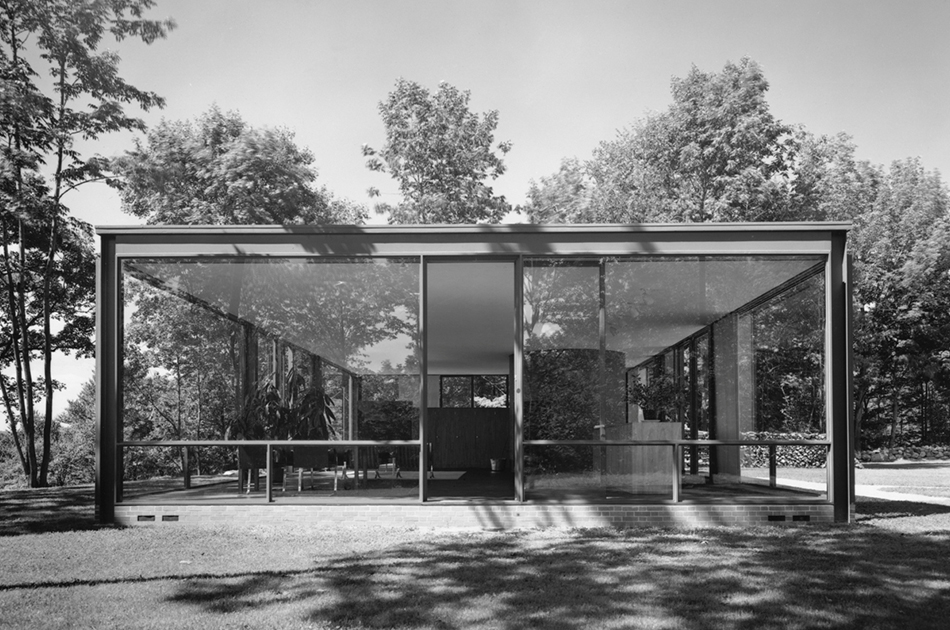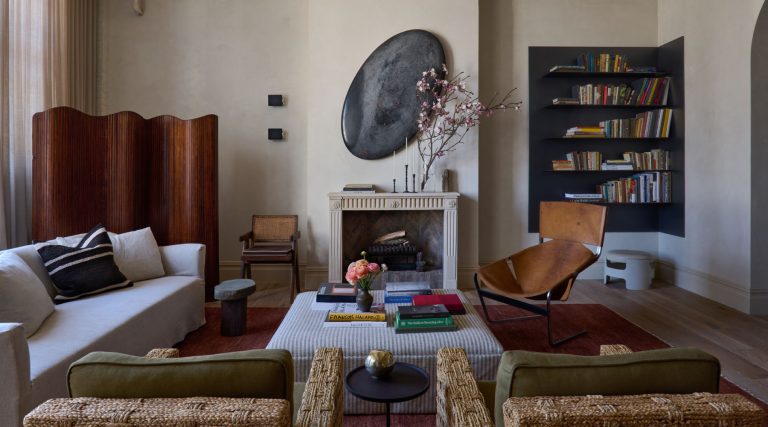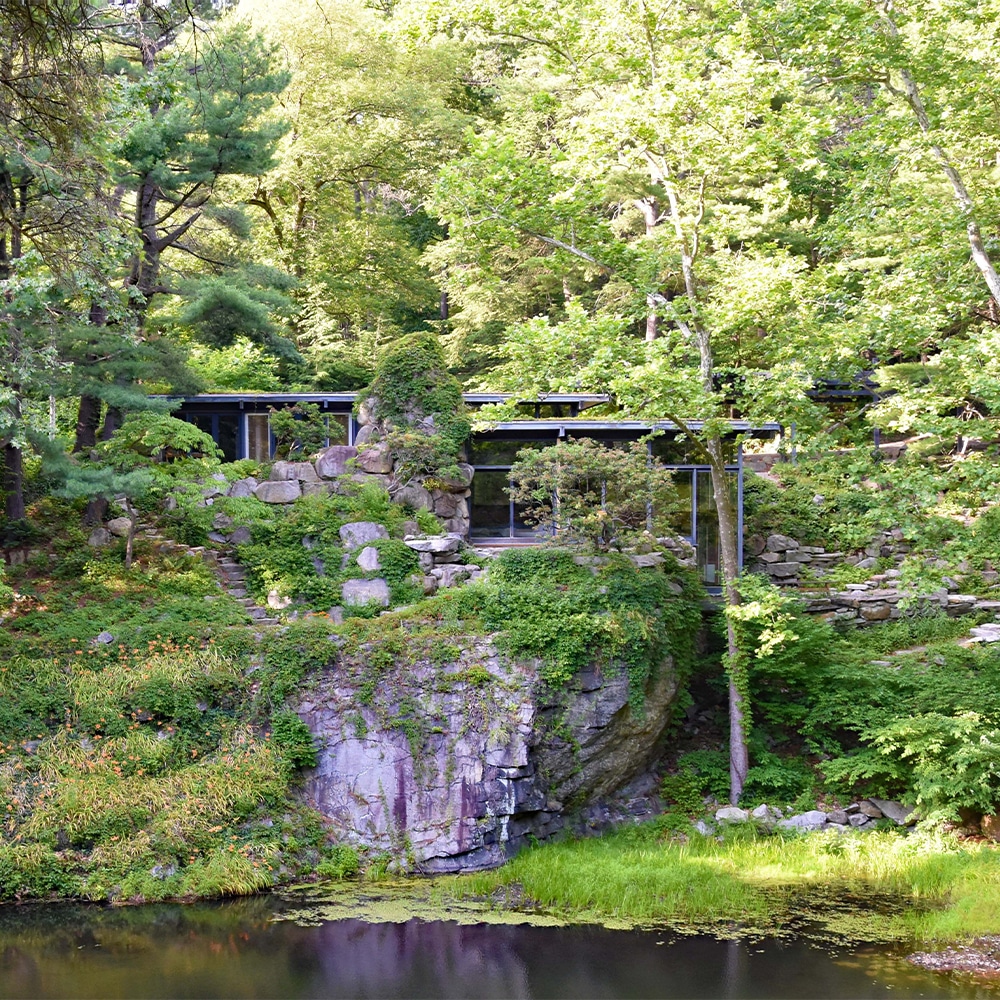
April 9, 2014Henry Urbach has served as director of Philip Johnson’s Glass House since 2012 (photo by Melani Lust). Top: The Glass House at night. Photo by Stacey Bass
More than a treasure, a monument or a landmark, Philip Johnson’s Glass House is an architectural icon. Designed by Johnson as his weekend retreat in New Canaan, Connecticut, and completed in 1949, the Glass House (and it is, the Glass House) is among the most emblematic buildings of the 20th century; as the world’s first residential structure faced entirely with large sheets of glass, it is the apotheosis of modernism and its dream of transparent architecture.
I am director of the Glass House, a 49-acre National Trust Historic Site that centers on the house itself as well as more than a dozen surrounding structures, most designed by Johnson, and an important on-site collection of modern art. Ours is an organization that works actively to maintain the building’s iconic status. I often encounter visitors, not to mention friends and colleagues, who come to the Glass House and approach it reverentially, sometimes with tears welling in their eyes. It is a site of pilgrimage, a place to pay homage to a kind of perfection, to an ideal, abstract and pure. Of course, I’ve been inside the house innumerable times, but I still have a sense of discovery every time I approach it, the feeling that I’m encountering something I haven’t seen before.
Now 65 years old, the Glass House was an icon from the get-go. Immediately after the structure was completed, it was featured in Life, House & Garden, Architectural Forum and the New York Times. Johnson, who would later win the first Pritzker Prize and grace the cover of Time, among innumerable other accolades, engaged the best photographers of his day, including Arnold Newman and Ezra Stoller, to photograph his creation. An architectural metaphor for exposure — one that insisted there was nothing whatsoever to hide (extraordinary considering that Johnson was a gay man spending weekends in suburban Connecticut in the 1950s, as well as a former Nazi-sympathizer rehabilitating his reputation in post-war America) — the Glass House continually exposed itself through print media and, later, television and film, with Johnson using it to craft his own celebrity to winsome effect. To this day, influential artists — Hiroshi Sugimoto, James Welling and Candida Höfer, among others — are drawn to the Glass House and to reinterpreting this icon.

Andy Warhol took this image of Johnson (left) and his partner, curator, editor and collector David Whitney, in 1984. Offered by Hedges Projects
If the house has been exposed again and again through media, it has played a more coy game of peekaboo with passersby. The Glass House is set a good distance from Ponus Ridge Road, where a six-foot-high stone wall and stand of river birch trees shield views downslope to the transparent pavilion. Over the years, many have scaled the wall or brazenly walked down the drive to gain a closer view, which Johnson understandably hated. A 1977 letter that recently came my way, however, reveals Johnson as somewhat more ambivalent about prying eyes: Dear so-and-so, he wrote: “I do not encourage people to visit my place; however, you seem interested enough to be allowed to see it. The weekends I keep for myself; so if you wish to come during the week when I am not in residence, you may do so.”
Inside the Glass House, a sense of timeless perfection was maintained by the permanence, over many decades, of spare furnishings and, in particular, the central seating arrangement, comprising chairs and a day bed, along with a glass coffee table, all by Mies van der Rohe. To be sure, minor adjustments have been made over the years, but only minor ones, which is striking, as all around the Glass House campus things were in constant flux: the landscape was transformed from heavily wooded into a pastoral, almost agrarian park; new pavilions — each in a different architectural language — were built; and major artworks were installed in the galleries and outdoors. Yet the Glass House itself, unchanging, was somehow perfect as it was, a stable center around which the experimental, the provisional, the restless could circulate.

A test run earlier this year hinted at the way Fujiko Nakaya’s forthcoming installation, “Veil at the Glass House,” will reveal and conceal the building behind an intermittent screen of dense mist. Image courtesy of the Glass House and Fujiko Nakaya
However timeless, the Glass House most definitely does exist in time, and it demands constant maintenance. We recently replaced the bed, the rug and the woven shade panels. The ceiling, smoke- and water-stained, is sagging in some areas, and other buildings on the site are in still greater need of repair. Yet Johnson himself seemed to welcome such entropic effects: For instance, he situated a 17th-century painting unprotected within the Glass House, so vulnerable to UV light that it has been on a regular restoration schedule ever since. Johnson also distributed memento mori, reminders of mortality, across the site, including an architectural folly he called the “Ghost House,” built on the ruins of a 19th-century dairy barn, and Julian Schnabel’s 1989 sculpture Ozymandias, after Percy Bysshe Shelley’s poem about the ravages of time. Each of these elements reflects on the impossibility of arresting time; their presence appears to offer a kind of counterpoint to the enduring, iconic quality of the house itself.
Since I became director of the site in 2012, we have been working to reactivate the Glass House as a place for new art and ideas, drawing inspiration from the curatorial and creative legacy of Johnson and David Whitney, Johnson’s life partner and an accomplished curator, editor and collector. I’m particularly excited about an upcoming installation, “Fujiko Nakaya: Veil,” which will contend with, and underscore, the iconic nature of the Glass House. From May through November this year, an occasional veil of dense mist will rise and fall to hide, then reveal, Johnson’s structure. The essential dream of the Glass House — to vanish — will be realized, or dramatized, during the course of the exhibition. Iconoclastic? Perhaps. But all the better to tease out the strange allure of this most revered glass box.








